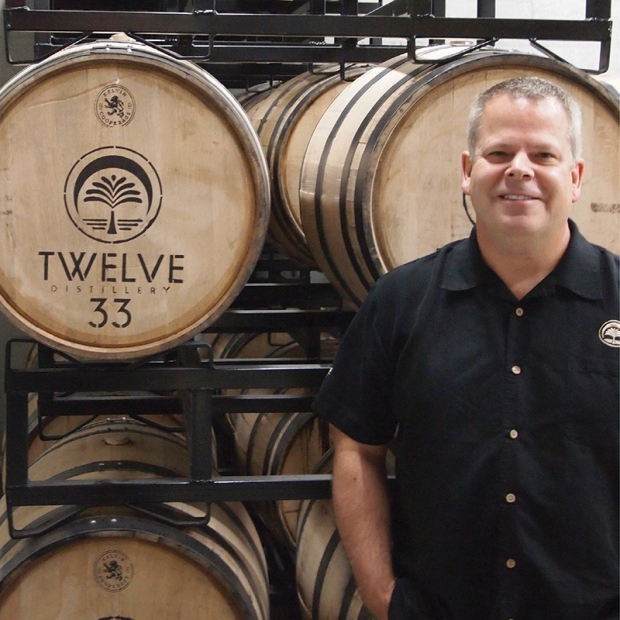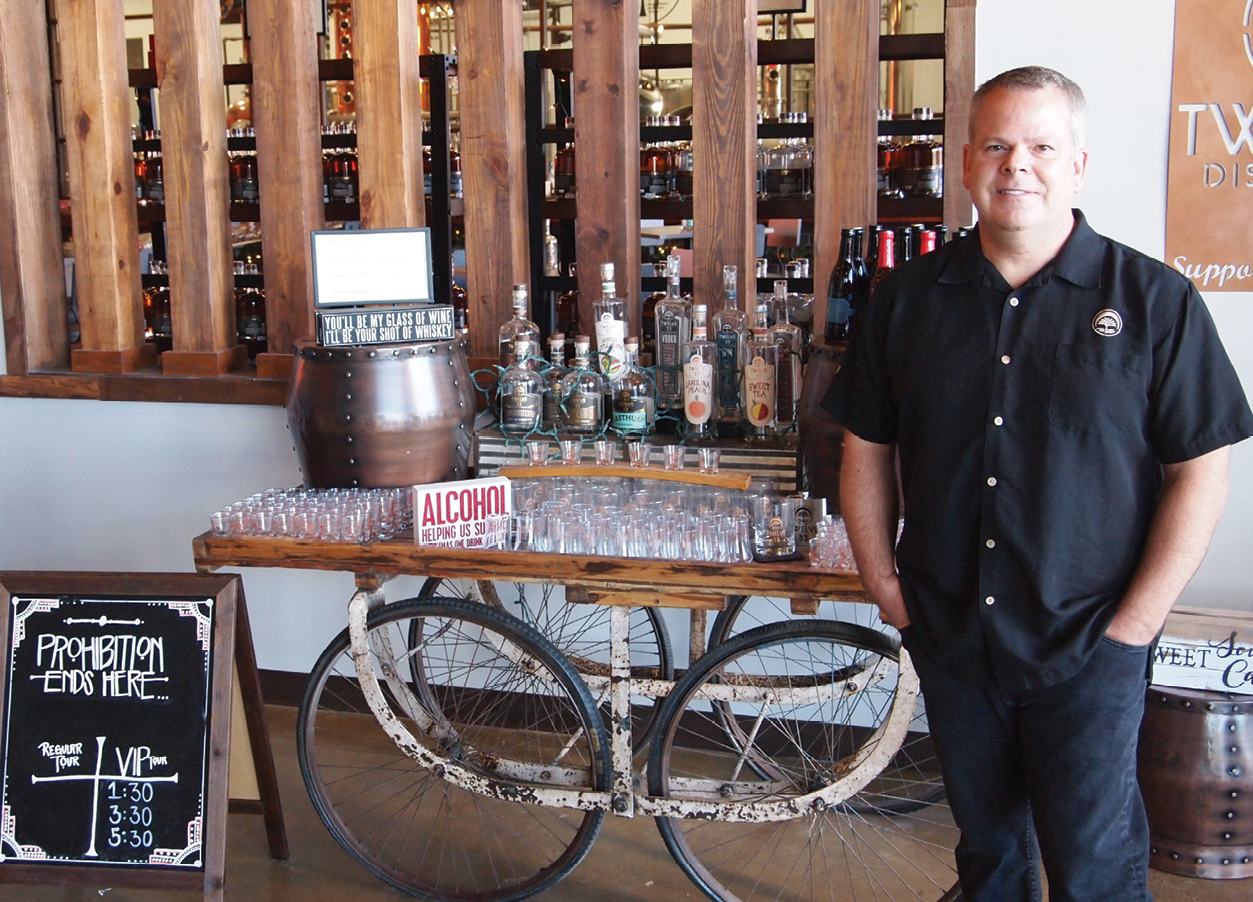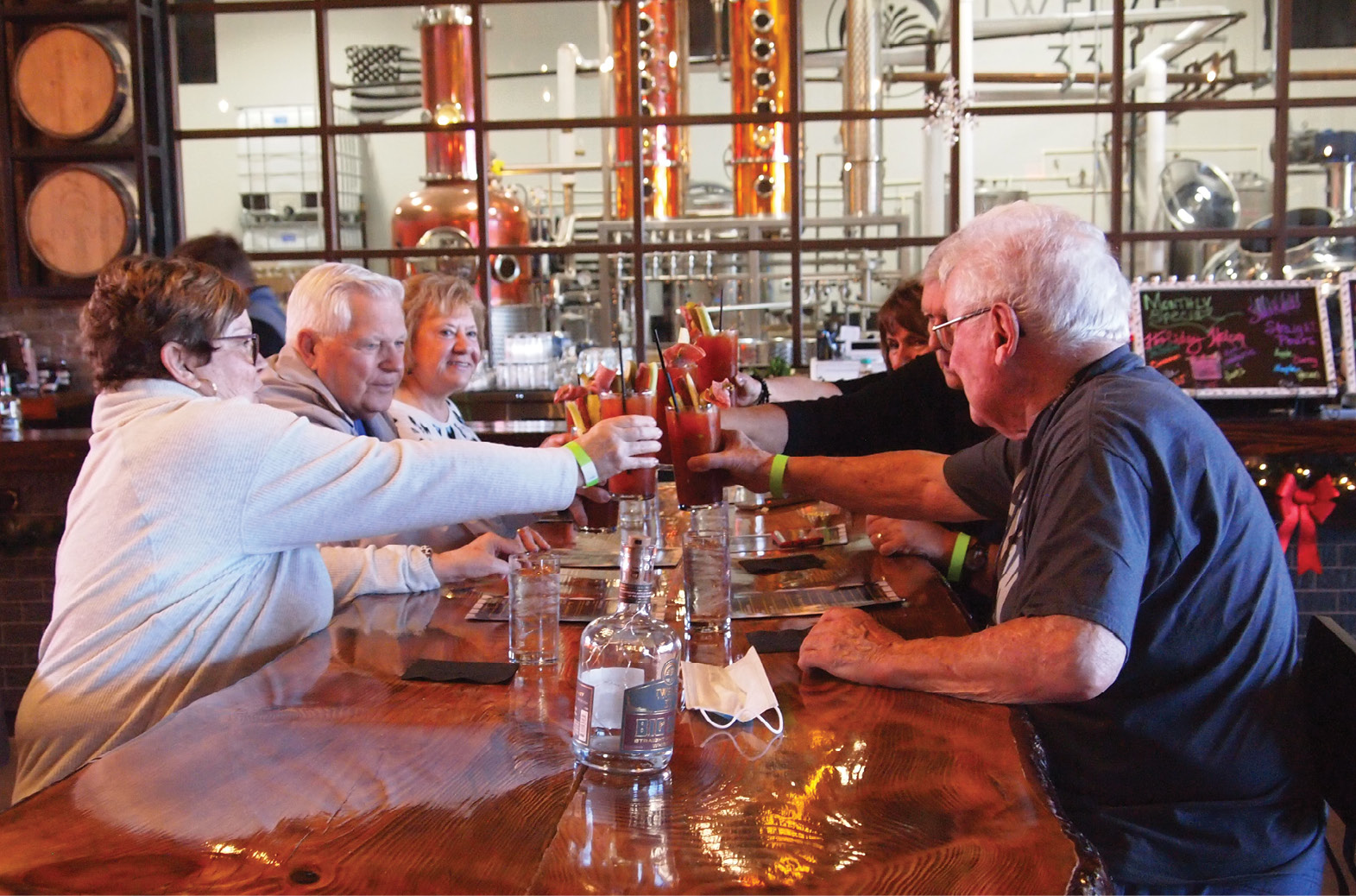A Day in the Life of Twelve 33’s Head Distiller, Kevin Osborn

My first observation of the effects of fruit turning into alcohol, and the unexpected results for those ingesting too much, came as a child when I witnessed drunken squirrels under our apple tree. I swear they were high-fiving each other while engaged in acrobatics that even the squirrels themselves seemed to find astounding. Doubled over with what looked like laughter, no fewer than six of the little partiers had been gorging themselves on the rotting, partially fermented apples, and I would later learn, were simply intoxicated.
This accidental, natural chemical process so thoroughly enjoyed by the squirrels that day has been finely tuned and scaled up so that almost anyone (of age) around the globe can responsibly enjoy imbibing on a bit of liquid courage from time to time, thanks to grain, fruit, sugar, yeast and a little bit of patience.
Many years later through…eh hem…research, I would find that the vastly complicated and fascinating world of distilled spirits rises far above the pedestrian uses of booze simply for intoxication. It’s about flavor, subtleties, nuance, tradition and ceremony, and, sure, maybe just a little buzz.
While historians argue that the oldest beverage on Earth is likely beer, distilled spirits (hard liquor) can’t be too far behind, dating back to at least 800 B.C. In our modern era, the same, simple processes I witnessed under the fruit tree have been refined through lots of trial and error, all thanks to the distillers who dedicate their lives and careers to making a bit of the good stuff.
South Carolina’s legislative bent toward strict, blue laws have eased over the decades to the point that the infamous Senator Strom Thurmond, who supported strict control, might be horrified to see just how far the state has shifted. With recent legislation easing taxation on the manufacture, distribution and sale of hard liquor, distillers have found the state more agreeable to the industry. Where, until 2011, South Carolina had no hard liquor distilleries, the state now boasts nearly 30 licensed operations, and that number is climbing.
Twelve 33 Distillery, among South Carolina’s most recently licensed, is located in Little River and is the only large operational distillery in Horry County. It’s also the only coastal distillery between Wilmington and Charleston, save retail branches of out-of-state distilleries at Broadway at the Beach and Barefoot Landing. The family-owned and operated business is a labor of love and involves a process as sophisticated and complex as any giant distillery around the world. I was lucky enough to watch, listen and learn (and taste) when co-owner and head distiller Kevin Osborn let me tag along for the day.

8:30 a.m.
I meet Osborn at the back door of Twelve 33, while dodging drive-thru traffic from the neighboring Dunkin Donuts; the two businesses share the highly visible corner entering Little River from the south on U.S. 17. Osborn, a Michigander by birth and most recently a Californian, relocated to the area with his wife, co-owner Rebecca Osborn, and were joined by their daughter, Alexandria Osborn, now all together in the family business.
The allure of decent weather, lower taxes and a less hectic lifestyle first appealed to the couple, and, so after scouting locations, they picked Little River as the “perfect place.” The team rehabbed an empty beachwear store and, after a significant and undisclosed investment, transformed it into a rather large, 10,000-square-foot distillery, tasting room and retail space, which opened in April 2019.
Once inside, I was introduced to the two stars of the show.
“This is Bonnie and Clyde,” says Osborn, walking me toward the large copper still named Clyde, and the only slightly smaller stainless steel stripping still named Bonnie, who still holds a respectable 500 gallons. Bonnie is used to rid the first distilled product of some very foul and dangerous chemicals in a process called “stripping.” It’s why illegal mountain moonshiners are supposed to pour off the first few jugs in their method, and why those who don’t can go blind or die from poisoning.
“It’s illegal to distill spirits without a license,” explains Osborn, “and it’s because of the nasty chemicals created in the process.”
Homebrewers can make wine and beer without licensing, but distilling hard liquor in your basement is akin to running a meth lab, with lethal toxic chemicals and explosive forces all combining to be potentially deadly hazards.
While Bonnie and Clyde are large, modern stills, there’s still something very ancient and prohibition-like in watching and learning about the process, which is essentially the same as the distillers from antiquity (and still made in the haunts and hollers of Appalachia).
“Prohibition was repealed in December of 1933,” Osborn says, “and so naming our distillery Twelve 33 seemed appropriate.”
8:46 a.m.
“When we mash-in, we start with around 350 gallons of hot water, heat that up to about 200 degrees, pitch in the grain—corn being the first—cook for about an hour,” Osborn explains. “Rum. by law, has no grain and is sugar-based; vodka can be made from almost anything. It’s all about the quality of the ingredients you begin with.”
The stills are both manufactured in Germany by Carl, one of the oldest still companies in the world. After a full year building, a German technician arrived in Little River just as assembly was finishing to train Osborn and run a few batches.
“It came in a lot of parts, in a lot of boxes with German instructions and 78 photos. It was like a German IKEA project,” he says.

9:00 a.m.
After logging notes about various chemical components and their relative strength (required by law and subject to periodic surprise inspection by state and federal authorities), Osborn adjusts valves on Clyde while making the day’s first batch of liquor. The distillery makes bourbon, gin, vodka, infused vodkas and rum.
“We don’t make moonshine,” notes Osborn. “There are plenty of distilleries in South Carolina that do, so we figured we’d let them do that, and we’ll do this.”
Moonshine, he tells me, is simply un-aged corn liquor; Twelve 33’s product is much more complex, sophisticated and refined.
Because of the distillery’s newness, the first batch of whiskey, which requires three years to age, is set to be tapped in February 2022. Another distiller currently makes Twelve 33’s bourbon and whiskey to Osborn’s “mashbill,” a fancy name for “recipe.” All other products sold and sampled are made in-house and require less aging.
“Bourbon really needs the time to mellow,” says Osborn. Other liquors can be distilled, aged for a short time and enjoyed right away. Many barrels of Twelve 33’s first bourbon run will age an additional two years, creating a five-year batch, and a few more will make it to 10 years.
“It’s hotly debated among distillers as what exactly the sweet spot is for aging,” says Osborn. “Whiskey definitely improves with age, but I personally feel that after 10 years it begins to degrade. But it’s a matter of taste.”
The distillery offers daily tours, when guests can get up-close-and-personal to the process, enjoy a craft cocktail and a sample tasting, and question Osborn, who is there every day except Sunday.
“We occasionally get another day off here or there,” he says, “but we’re here most of the time.”
Regularly putting in 12-hour days, the job of head distiller came with a lot of training and requires a lot of work. Osborn’s certification and education came both from Cornell University in Ithaca, New York, and the Distilled Spirits Epicenter (home of Moonshine University) in Louisville, Kentucky. He and the distillery are both federally and state licensed.
10 a.m.
By now, marketing manager Alexandria Osborn, along with operations manager Paul Lankford, have arrived and are in full work mode. The VP of operations, Rebecca Osborn, too, has arrived. She’s brought with her the fun-loving distillery dog, Rocco, a 1-year-old English Cream Golden Retriever. Rebecca will be labeling bottles in a corner of the tasting room while trying to manage Rocco’s expectations for fetch, his singular obsession.
“I manage back of house, which is production,” says Kevin Osborn, “and Rebecca manages front of the house, which is bar and retail. Paul floats around and helps wherever and whenever.”
A brand ambassador, Tess Sanford, works to get the word out as the company makes a name for itself.
Making the move from corporate jobs to full-time distilling comes with a significant dedication to the craft.
“It’s a three- to four-year process for education, certification and build out,” says Osborn. “I made wine and craft spirits in California as kind of a side gig—a very small operation. My partners and I all had real corporate jobs. I worked for West Marine. We had friends that had opened a distillery and really loved what they were doing. My company got bought out, and we saw the writing on the wall and executive management is always first to go. So we thought, we don’t have to stay in California; our kids were in college. At the time, there were [less than 20] craft distilleries in South Carolina, and the costs of manufacturing and cost of doing business was much more attractive here. We already had family here along the Grand Strand and elsewhere in the Carolinas, so here we are.”
10:44 a.m.
Osborn leads me to crates stuffed with South Carolina peaches, grown at Bell Farms in Longs. Twelve 33’s Carolina Peach Vodka is a bestseller.
“We use all South Carolina ingredients, in all of our products, as much as possible,” says Osborn.
“Each batch of Carolina Peach Vodka requires one bushel of peaches,” he says, showing me the tank that holds the peaches and infuses the vodka with a distinctly Carolina peach essence. “Depending on what we’re making, each batch of liquor requires [up to] 800 pounds of grain. Rum, by law, is made from sugar. We use Grade-A molasses, the highest grade available, for both our Silver Rum and our Spiced Rum. For our Barrel-Aged Rum, we use black strap molasses, which adds fantastic flavors when aged.”

12:15 p.m.
With the doors opening in 45 minutes, Osborn moves us to the front of the house. With a long bar, stylized wood plank interior, soaring ceilings, and plenty of long wooden tables to accommodate large crowds, the Tasting Room offers a not-so-subtle nod to the prohibition era. Clever, era-appropriate slogans adorn the walls, shelves of sample product let visitors know what’s available, and, in one corner, Rebecca Osborn sits dutifully at the labeling machine, applying Twelve 33 stickers to fresh bottles. Each bottle is hand-labeled and hand-filled.
“We are currently able to produce and sell around 100,000 bottles annually,” says Kevin Osborn, leading me to an empty wall that at first glance looks just like another wooden wall in the building.
There’s a curious, carved lion’s head, another nod to the era when liquor manufacture, sale and consumption was prohibited.
“If you look closely, you can see the hinges,” he says with a sly grin. “Say the magic word into the lion’s head and you gain entrance.” He pops open the formerly hidden door to reveal Twelve 33’s Speakeasy, a private bar and lounge reserved for those with VIP tour tickets.

The Speakeasy is dimly lit and has a few couches and overstuffed chairs, as well as a stand-up bar for tastings, where I am treated to small samples, known as a “flight”: bourbon, whiskey, rum, gin and a chocolate and peppermint holiday liqueur. All delicious and just enough to make you want more.
“By law, we can sell each person two drinks per day,” says Osborn, “and three bottles per person, per day.”

A cocktail at the bar and flight constitute the two drinks allowed. Currently tours and tastings are priced at $25, which includes the drink and the flight, and the VIP tour of the distillery’s production rooms and Speakeasy. Tours are limited to 10 persons and run as often as demand calls for. Additionally, guests may enter the distillery without booking a tour and order from the retail store and bar, which is exactly what a loyal group of regulars were up to on the day I visited.
1:15 p.m.
A hearty group of Little River-area retirees meet every week for a Bloody Mary, sometimes two, which they say is the best they’ve ever had. It’s called the Bloody Abe Froman, named for Ferris Bueller’s “sausage king of Chicago.” Using Twelve 33’s 3 Peppers Vodka—infused with a blend of locally grown jalapeno, habanero and Carolina Reaper peppers—the drink packs a punch and is loaded with all the accouterments a good Bloody Mary requires, including several sausage and salami tidbits and more; a meal unto itself.

At the bar, head mixologist McKayla Wilkie makes a specialty smoked cocktail and is in charge of all cocktail designs. On busy days and early evenings, the tasting room is socially distanced, but full. By the nature of the two-drink maximum, guests turn over more frequently than at a typical bar, and because Twelve 33 is governed by liquor store laws, they must close by 7 p.m. and do not open on Sundays.
2:00 p.m.
With plenty left to do, and Osborn’s day barely half done, I make my way out, past Rocco, who looks at me longingly, hoping I’ll throw the ball one more time. I oblige and he scurries off while I ask Osborn how the pandemic has affected business.
“We’ve actually managed well and can’t complain,” he says. “We have the tasting room as a revenue stream, and we sell our bottled spirits. I’m sure you’ve heard the spirits business, in general, is through the roof. We went about two months without a tasting room, but during the shut down last March, we made hand sanitizer, like many of the distilleries. Only pharmaceutical companies and distilleries are allowed by law to make hand sanitizer, so as an industry, we got together. We knew we needed to and wanted to help the community and we got to work. We got permission in record time. We had to follow the WHO (World Health Organization) formula and we made (sanitizer) for about three months. For the first three weeks, we donated to local first responders—about the equivalent of $50,000 worth. In the beginning, we told anybody that could bring a bottle in, we’d give them four ounces for free, and every morning we had a line down our sidewalk. We eventually started selling—and still do—sanitizer at a nominal cost.”

And after reopening?
“We had a slow summer and a great fall, and are really looking forward to a much brighter 2021.”
Cheers to that.
Reservations required for tours ($25); no admission fee for bar/retail, 21 and over only. Address: 593 SC-90 E., Little River. Phone: (843) 663-3344; Web: twelve33distillery.com. Open Monday–Friday. 1–7 p.m.; Saturday, noon–7 p.m. Closed Sunday.